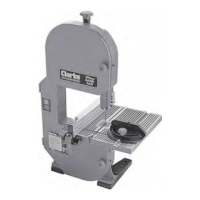RIP SAWING
This term refers to the cutting of the timber with
the grain, rather than at a right angles to the
grain. You can rip wood freehand to a previously
drawn line, but best results are obtained by using
the rip fence.
If the table is set at a level angle, set the rip fence
to the left hand side of the blade for long pieces,
allowing you to use your right hand to support
the work and your left hand, or pushstick to feed
the work into the blade and held firmly against
the fence.
For shorter pieces you may set it to the right as
shown in fig. 7, using your right hand to hold the
work firmly to the table and rip fence.
Fig. 8 shows a similar operation with the table set
to produce a 45º bevel.
CROSS CUTTING
This term refers to cutting timber at right angles to
the grain. This type of cut can also be made
freehand, but the mitre gauge is used to ensure
accurate results. The mitre gauge can be
adjusted to a angles up to 45°, to produce mitre
cuts, or with the table tilted as well - compound
mitre cuts. Make sure the work is held firmly
against the table and against the face of the
mitre gauge. Be careful to keep your fingers
away from the blade, particularly at the end of
the cut.
Slide the Gauge and workpiece together, across
the table with the guide bar engaged in the slot
provided as shown in Fig. 9.
NOTE:
In each of the illustrations, for clarity, the left hand has
been omitted, however, in practice it would be used
to support and guide the workpiece, on the opposite
side of the blade, wherever possible.
FREEHAND SAWING
The ease with which many different and varied
shapes can be cut is one of the most important
features of the bandsaw.
When freehand cutting, always feed the work
slowly so that the blade can follow the line you
wish to cut. Make sure not to drag the work off
line, forcing the blade sideways, or twisting it.
In many cases, it is helpful to rough cut about
6mm away from the line. For difficult curves
which may be too tight for the blade, make relief
cuts at 90° to the face of the curve so that these
scraps will fall away as the final radius is sawn.
Fig. 9
Fig. 8
Fig. 7
9

